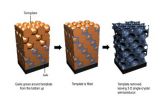(Press-News.org) Writing in the journal Nature Physics, the academics, who discovered the world's thinnest material at The University of Manchester in 2004, have revealed more about its electronic properties.
Research institutes and universities around the world are already looking at ways to build devices such as touch-screens, ultrafast transistors and photodetectors.
Now the research from the creators of the material promises to accelerate that research, and potentially open up countless more electronic opportunities.
The researchers, from the universities of Manchester, Madrid and Moscow, have studied in detail the effect of interactions between electrons on the electronic properties of graphene.
They use extremely high-quality graphene devices which are prepared by suspending sheets of graphene in a vacuum.
This way most of the unwanted scattering mechanisms for electrons in graphene could be eliminated, thus enhancing the effect of electron-on-electron interaction.
This is the first effect of its kind where the interactions between electrons in graphene could be clearly seen.
The reason for such unique electronic properties is that electrons in this material are very different from those in any other metals. They mimic massless relativistic particles – such as photons.
Due to such properties graphene is sometimes called 'CERN on a desk' – referencing the Large Hadron Collider in Switzerland. This is just one of the reasons why the electronic properties are particularly exciting and often bring surprises.
Professor Geim and Professor Novoselov's pioneering work won them the Nobel Prize for Physics in 2010 for "groundbreaking experiments regarding the two-dimensional material graphene".
The pair, who have worked together for more than a decade since Professor Novoselov was Professor Geim's PHD student, used to devote every Friday evening to 'out of the box' experiments not directly linked to their main research topics.
One Friday, they used Scotch tape to peel away layers of carbon from a piece of graphite, and were left with a single atom thick, two dimensional film of carbon – graphene.
Graphene is a novel two-dimensional material which can be seen as a monolayer of carbon atoms arranged in a hexagonal lattice.
It possesses a number of unique properties, such as extremely high electron and thermal conductivities due to very high velocities of electrons and high quality of the crystals, as well as mechanical strength.
Professor Novoselov said: "Although the exciting physics which we have found in this particular experiment may have an immediate implementation in practical electronic devices, the further understanding of the electronic properties of this material will bring us a step closer to the development of graphene electronics."
Professor Geim added: "The progress have been possible due to quantum leap in improvement of the sample quality which could be produced at The University of Manchester."
### END
Graphene's 'quantum leap' takes electronics a step closer
2011-07-25
ELSE PRESS RELEASES FROM THIS DATE:
Pocket chemistry: DNA helps glucose meters measure more than sugar
2011-07-25
CHAMPAIGN, Ill. — Glucose meters aren't just for diabetics anymore. Thanks to University of Illinois chemists, they can be used as simple, portable, inexpensive meters for a number of target molecules in blood, serum, water or food.
Chemistry professor Yi Lu and postdoctoral researcher Yu Xiang published their findings in the journal Nature Chemistry.
"The advantages of our method are high portability, low cost, wide availability and quantitative detection of a broad range of targets in medical diagnostics and environmental monitoring," Lu said. "Anyone could use it ...
New photonic crystals have both electronic and optical properties
2011-07-25
CHAMPAIGN, Ill. — In an advance that could open new avenues for solar cells, lasers, metamaterials and more, researchers at the University of Illinois have demonstrated the first optoelectronically active 3-D photonic crystal.
"We've discovered a way to change the three-dimensional structure of a well-established semiconductor material to enable new optical properties while maintaining its very attractive electrical properties," said Paul Braun, a professor of materials science and engineering and of chemistry who led the research effort.
The team published its advance ...
Epigenetic 'memory' key to nature versus nurture
2011-07-25
Researchers funded by the Biotechnology and Biological Sciences Research Council (BBSRC) at the John Innes Centre have made a discovery, reported this evening (24 July) in Nature, that explains how an organism can create a biological memory of some variable condition, such as quality of nutrition or temperature. The discovery explains the mechanism of this memory – a sort of biological switch – and how it can also be inherited by offspring.
The work was led by Professor Martin Howard and Professor Caroline Dean at the John Innes Centre, which receives strategic funding ...
Soft spheres settle in somewhat surprising structure
2011-07-25
Latex paints and drug suspensions such as insulin or amoxicillin that do not need to be shaken or stirred may be possible thanks to a new understanding of how particles separate in liquids, according to Penn State chemical engineers, who have developed a method for predicting the way colloidal components separate based on energy.
"The ongoing assumption was that if you have a mixture of different sized particles in a liquid, the faster-settling particles will end up on the bottom," said Darrell Velegol, professor of chemical engineering. "We found that in many cases it ...
Mismatch between cancer genetics counseling and testing guidelines and physician practices
2011-07-25
A new analysis has found that many doctors report that they do not appropriately offer breast and ovarian cancer counseling and testing services to their female patients. Published early online in CANCER, a peer-reviewed journal of the American Cancer Society, the study indicates that efforts are needed to encourage these services for high-risk women and discourage them for average-risk women.
Women with mutations in the BRCA1 or BRCA2 gene have a substantially increased risk of developing breast and ovarian cancer, but there are medical treatments that can dramatically ...
Children eating more, and more frequently outside the home
2011-07-25
Philadelphia, PA, July 25, 2011 – As childhood obesity rises and the American diet shifts towards increasing consumption of foods eaten or prepared outside of the home, concerns about the nutritional quality and the total consumption of such foods are also increasing. According to a study conducted at the University of North Carolina at Chapel Hill and published in the August 2011 issue of the Journal of the American Dietetic Association, eating location and food source significantly impact daily energy intake for children. Foods prepared away from home, including fast ...
Catching the West Nile virus in action
2011-07-25
Tel Aviv — Since 1999, several outbreaks of West Nile Virus, which causes fever or severe neurological symptoms and is transmitted from birds to humans by blood-sucking mosquitoes, have been seen in the U.S., usually during the summer months. But researchers aren't certain how the virus migrated here — and they don't know how, or where, it will appear next.
Now Prof. Ella Mendelson of Tel Aviv University's School of Public Health at the Sackler Faculty of Medicine, working with the Israeli Ministries of Health and Environment, has instituted a study that tracks both clinical ...
Double jeopardy: Tuna and billfish
2011-07-25
MIAMI – July 25, 2011 – A new study by top global fisheries experts presents an alarming assessment of several economically important fish populations. The analysis of 61 species of "scombrids," which include tunas, bonitos, mackerels and Spanish mackerels, and billfishes, which include swordfish and marlins, classified seven as threatened with extinction and four as "near threatened" for the IUCN Red List of Threatened Species.
University of Miami Rosenstiel School of Marine & Atmospheric Science associate professor, and assistant director of NOAA's Cooperative Institute ...
Pekasus, Factory of Animated Dreams, Today Announces the Publication of its Newest Book in its Ongoing Series, Spark the Stone Man
2011-07-25
The book's 16 full-color illustrations are the handiwork of British Academy Award recipient and Oscar nominee, Olga Titova. Another key participant in the project is Aida Zyablikova, a movie director and a British Academy Award recipient and Oscar nominee.
Asya Pekurovskaya says there will eventually be six books in the Spark's series. Two have now been published and two more are waiting in the wings. She is currently at work finishing the final two. Each book, she says, stands on its own but also builds upon earlier books and the Spark the Stone Man cosmology. The entire ...
Win Top Technology Prizes with Cake Poker and RakeTheRake
2011-07-25
In celebration of its recent relaunch, RakeTheRake has three superb technology prizes to be won, courtesy of Cake Poker. The promotion is part of a three month period of special relaunch promotions , running until 31 July. Worth $100k+, these promotions are on top of the regular $500k+ of monthly promotions at RakeTheRake.com.
Cake Poker players can play to win one of these great prizes: 1st place will win an X-box and a large screen TV; 2nd place will win a new iPad2 and 3rd place will receive a notebook.
Cake Poker players can enter by checking the rake requirements ...




